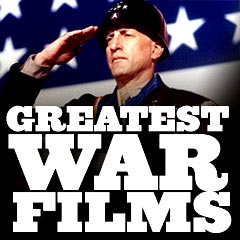
|
Greatest War Movies 1940s-1 |
| Film Title/Year/Director, War-time Setting and Brief Description | ||
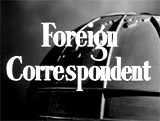
|
Foreign
Correspondent (1940)
When the war in Europe commenced in 1939 with the Nazi invasion of Poland, British film directors tried to alert Americans to the looming German and Italian Fascist threat. Alfred Hitchcock's political/war-time thriller - his second American film, contained many memorable scenes, including the faked assassination scene of Dutch diplomat Van Meer on the steps of Amsterdam's Town Hall and the flight of the assassin in the midst of a crowded sea of umbrellas, a mysterious Dutch windmill serving as a hideout for Nazi spies, a failed murder attempt atop Westminster Cathedral Tower, and a spectacular trans-Atlantic ocean plane crash. NY crime reporter Johnny Jones/Huntley Haverstock (Joel McCrea) had been sent to Europe to report on the crisis, and unwittingly found himself embroiled in the troubling situation when he uncovered a nefarious spy organization run by Stephen Fisher (Herbert Marshall), the father of his love interest Carol (Laraine Day). It concluded with Johnny's plea to the neutral American public to enter the war, as bombs fell on the darkened radio studio in London: ("It's as if the lights were all out everywhere, except in America. Keep those lights burning there! Cover them with steel! Ring them with guns! Build a canopy of battleships and bombing planes around them! Hello, America! Hang on to your lights. They're the only lights left in the world..") |

|
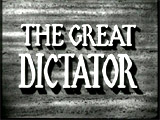
|
The Great Dictator (1940)
Charlie Chaplin lampooned Adolf Hitler (in the role of Adenoid Hynkel) and the Third Reich in this film, the director/actor's first all-talking picture - it was Chaplin's last film with the Little Tramp character. The film was a slapstick satire on world conditions and fascism at the start of World War II. Chaplin played a dual role: as a poor, unnamed Jewish ghetto barber, and as a Hitler look-alike, the ruthless tyrannical dictator Adenoid Hynkel of the European country of Tomainia. Hynkel's rival was Mussolini-like Benzino Napaloni (Jack Oakie) of Bacteria. In the conclusion, the barber and the dictator became involved in a case of mistaken identities. With a memorable scene of Hynkel dancing with a world globe balloon. The film concluded with a lengthy monologue about hope and human rights. Hitler banned German audiences from viewing the picture due to its offensive characterization and even some American audiences believed that Chaplin had become self-indulgent. |

|

|
Northwest Passage (1940)
This misleadingly-named film included the retaliatory attack by Rogers' Rangers, a rag-tag colonial army led by Major Robert Rogers (Spencer Tracy), on Saint-François-du-Lac, Quebec, a settlement of the Abenaki Indians. The adventure-war film dramatized part of Kenneth Roberts' 1937 epic novel of the same name. The purpose of the brutal raid in 1759 was to avenge the many attacks on British settlers and deter further attacks by French-allied Indians. The force of 160 men, after meeting with starvation and being stranded, was whittled down to about 50 survivors after a long agonizing retreat. |

|

|
The Sea Hawk (1940)
This exciting swashbuckler, one of the best of its kind, was adapted from the novel by Rafael Sabatini. Set in the 16th century, Queen Elizabeth I of England (Flora Robson) suspected that Spanish King Phillip II (Montagu Love) and his crafty ambassador Don Jose Alvarez de Cordoba (Claude Rains) were planning to spread their influence over the continent. The Spaniards were getting ready to launch a naval attack with their armada against England. The Queen secretly commissioned swashbuckling privateer, British sea captain Geoffrey Thorpe (Errol Flynn), "the Sea Hawk," to raid Spanish settlements and ships. While threatening the Spanish, the beautiful daughter of the ambassador Donna Maria (Brenda Marshall) fell in love with Thorpe. He and his crew were ambushed and imprisoned by Spanish forces. With Maria's aid, he escaped slavery aboard a Spanish galleon slave ship, and helped alert the Queen to the impending Armada attack. |

|
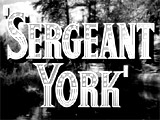
|
Sergeant York (1941)
One of the most effective films to promote heroic US patriotism was this war-related film starring Gary Cooper (who won his first Best Actor Academy Award for his role) as real-life, backwoods, conscientious-objecting Tennessee backwoods mountain boy/farmer and pacifist Alvin C. York. It was the true, but unusual story of World War I's biggest war hero, who fought in the war, mostly as a great marksman, and single-handedly captured a large regiment of 132 German soldiers during the Battle of Argonne, becoming the most decorated soldier of the war. With fast-paced action sequences and some wartime propagandizing. |
 
|

|
They Died With Their Boots On (1941)
Although wildly historically inaccurate, Raoul Walsh's sweeping and entertaining Hollywoodish portrait of the West included a dashing view of General George Armstrong Custer (Errol Flynn), opposite his devoted wife Elizabeth (Olivia de Havilland). Anthony Quinn also starred as Crazy Horse. The formulaic adventure film was released during wartime to meet audiences' demands for a flamboyant military hero. |

|

|
The best-loved film of all time, a perennial-favorite, a must-see classic and Best Picture. A tale of pre World War II intrigue, patriotism, romance, love lost, heroism, and conscience, with a well-paced dialogue, sentimental script, moody and atmospheric sets, and a first-rate cast of memorable characters. Set during World War II in Casablanca (North Africa) at a seedy Algerian saloon/nightclub run by cynical saloonkeeper Richard "Rick" Blaine (Humphrey Bogart). The Cafe Americain was filled with European refugees, smugglers, thieves and Nazis (commanded by Major Strasser -- Conrad Veidt). Into his joint walked now-married long-lost-love Ilsa Lund Laszlo (Ingrid Bergman) and her underground Resistance freedom-fighter husband Victor Laszlo (Paul Henreid), who were trying to arrange their escape from the Nazis. The popular film emphasized the atmospheric intrigue and tension surrounding Humphrey Bogart's decision to assist the war effort and get involved by securing transit visas - and give up the one-time love of his life, the often tragic consequences for lovers caught up in wartime experiences. |
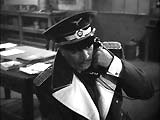 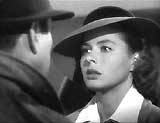
|

|
In Which We Serve (1942, UK)
The British cinema continued to produce many propagandist, flag-waving war films glorifying their "finest hour" of battle against Germany and Japan, including this inspiring film. This was a stirring, patriotic, British WWII drama. The film was the directorial debut of David Lean with Noel Coward as producer, writer, co-director, and star. The story, about a valiant torpedoed crew of Lord Mountbatten's British destroyer (HMS Torrin), commanded by Captain Kinross (director Noel Coward) during the Battle of Crete in WWII, was told in a non-linear fashion with vignettes or flashbacks. It was filmed like a documentary, with narration recounting the historic efforts of the crew as they survived the ship's sinking and struggled on a raft, while they flashed back to memories of their loved ones. |

|
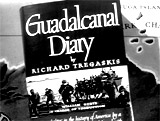
|
Guadalcanal Diary (1943)
This exciting, flag-waving, documentary-style adventure film was adapted from war correspondent Richard Tregaskis' 1943 non-fiction book. It starred Anthony Quinn (as Latino Jesus 'Soose' Alvarez), William Bendix (as pugnacious New Yorker soldier Corporal "Taxi" Potts), Richard Jaeckel (as young "Chicken"), Lloyd Nolan (as gunnery Sergeant Hook Malone) and Preston Foster (as Father Donnelly). This propagandistic, slightly sanitized film bolstered homefront morale -- it was rapidly released soon after the actual battle -- as it portrayed the US Marine Corps' courageous and bloody months-long battle for the Japanese-held Solomon Islands during the opening stages of the war in the South Pacific. |
 
|
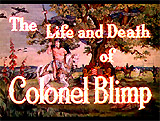
|
The Life and Death of Colonel Blimp (1943, UK)
The Technicolor film that satirized the British military establishment used the name of Sir David Low's comic strip, The Life and Death of Colonel Blimp, "Colonel Blimp" in the film's title referred to a 1930s English cartoon character, not a real personage. The film was held up in its release to the U.S. until 1945. Powell and Pressburger's satirical character study was a controversial wartime film that angered Winston Churchill for its portrait of a 'fuddy-duddy' 40 year career soldier, in the character of rotund Clive Candy (Roger Livesey). He fought in the Boer conflict and through both world wars - although he still maintained outdated notions about how to be a gentlemanly soldier and conduct war by following the rules, unable to adapt to the methods and realities of modern warfare. During his life, Candy kept a friendship with his German counterpart - a former German soldier Theo Kretschmar-Schuldorff (Anton Walbrook). During the course of his life, dedicated to the king and his country through changing times, he also met and loved three women: Edith Hunter / Barbara Wynne / Johnny Cannon (all played by Deborah Kerr in a very versatile role). |
 
|

|
Sahara (1943)
Zoltan Korda's dramatic action picture was centered in the N. African Libyan desert, with Humphrey Bogart as Army Sgt. and Lulubelle tank commander Joe Gunn - the head of a British-American unit fighting the Germans. Cut off by German General Rommel's forces, he was forced to cross the Sahara desert, picking up various Allied soldier-stragglers (of various nationalities) on their way to an oasis - also the destination of outnumbering German troops. |

|

|
Hail the Conquering Hero (1944)
A fast paced, zany Preston Sturges comedy satire on war-time patriotism and hysteria, human nature, motherhood, and hero-worship. World War II Marine Corps 4-F reject (due to hay fever) Woodrow Lafayette Pershing Truesmith (Eddie Bracken), ashamed and embarrassed to admit his lack of fitness for duty, masqueraded as a soldier - he worked in a defense plant/shipyard but wrote letters home telling of his military exploits. He allowed a group of sympathetic yet drunken Marines to pass him off as a true war hero to deceive his hometown folks when he returned home. Woodrow was "hailed as the conquering hero." The people in the small town of Oakridge believed the charade that he was a hero, and even nominated him for mayor to replace the current corrupt one (Raymond Walburn). |
 
|
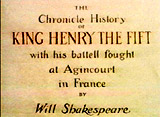
|
Henry V (1944,
UK) (aka The Chronicle History of King Henry the Fift with His
Battell Fought at Agincourt in France)
Laurence Olivier adapted, produced/directed (his first and most successful effort), and starred as the title character in one of the greatest Shakespearean adaptations ever made. It told the tale of Britain's victory over the French at Agincourt (and was famous for the line: "Once more unto the breach, dear friends, once more"). During England's besieged condition against the Nazis, the Technicolor epic was dedicated to the fighting forces and stiff resolve of Britons. Olivier masterfully merged the set of the Globe Theatre with on-location set-pieces. The film wasn't released in the US until 1946, when Olivier received a special Honorary Academy Award for "his outstanding achievement as actor, producer and director in bringing Henry V to the screen." |
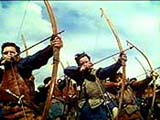
|
(chronological by film title) Introduction | 1900s-1920s | 1930s | 1940s-1 | 1940s-2 | 1950s | 1960s-1 | 1960s-2 | 1970s | 1980s | 1990s | 2000s | 2010s |